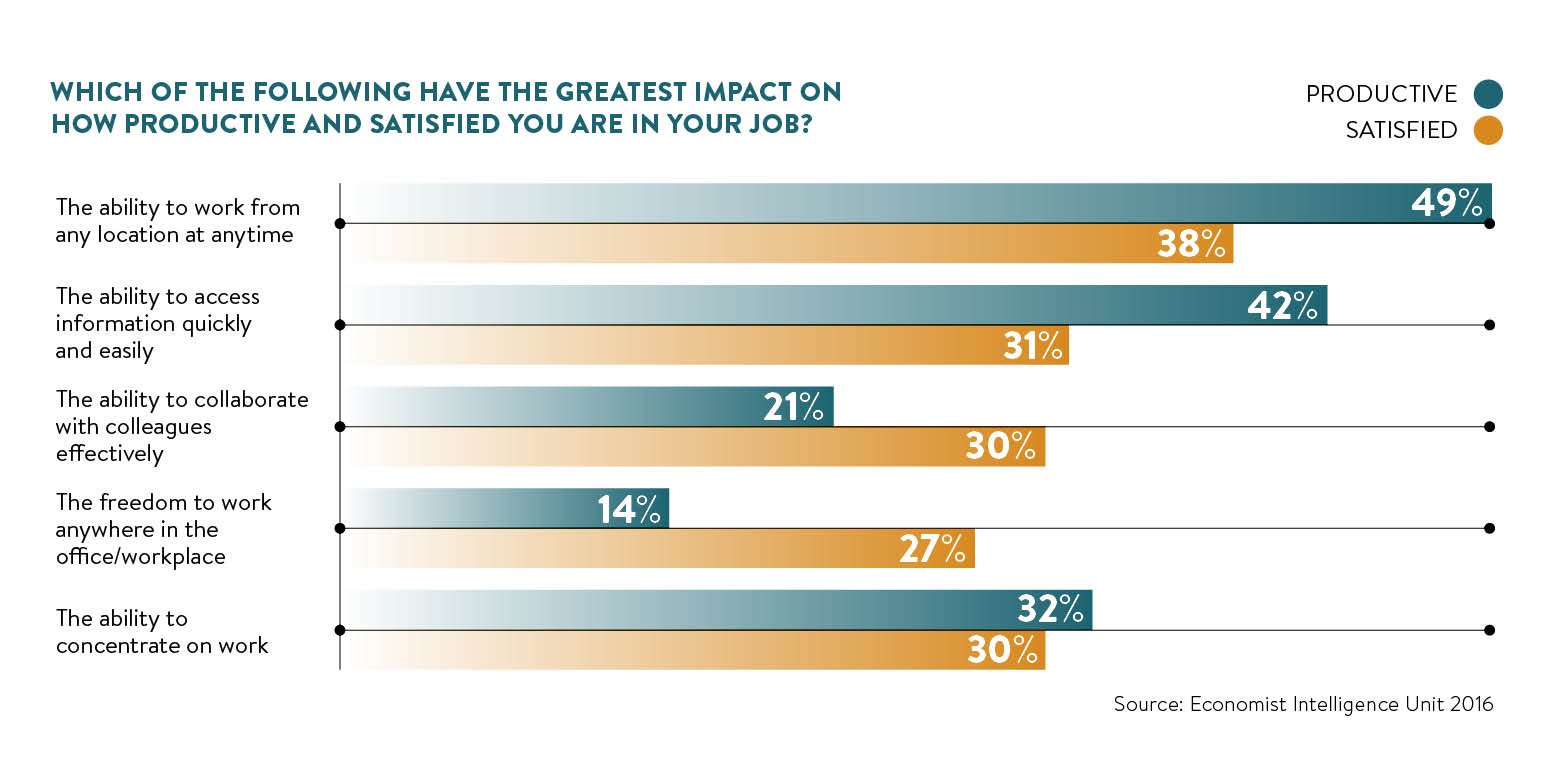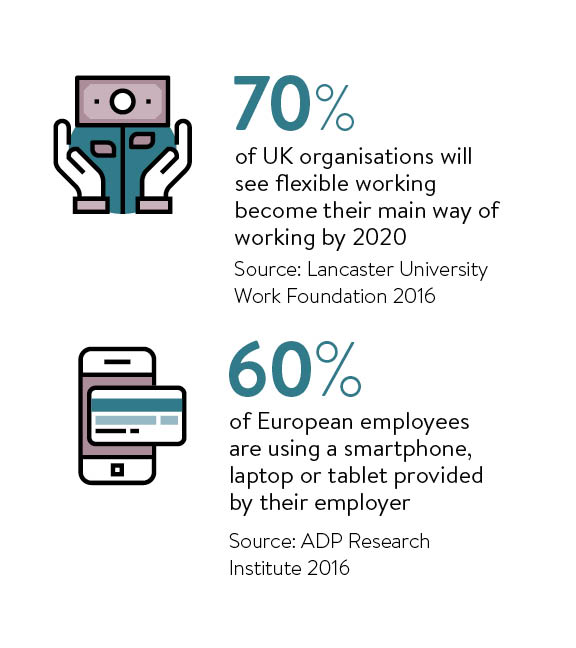The statutory right for employees to request flexible working, enshrined in UK law two years ago, was a catalyst for making the unconventional – working from home, on the move or in multiple locations across workplaces – become the norm.
In order to keep their increasingly flexible workforces connected, engaged and productive, organisations have had to rethink workplace communications. For many the solution has been to implement a unified communications and collaboration (UC&C) strategy, providing access to new communication technologies across a range of media, including web, chat, e-mail, screen-sharing and web-conferencing. In the workplace of the future, employees will demand nothing less.
Flexibility good for business
“Flexible working has become the norm and employers who restrict it can often find their staff feeling constrained, and can even lose key employees or projects due to a rigid work environment,” says David Walsh, chief executive and chairman of communications firm Genband. “This is leading many companies to realise they need an up-to-date communications strategy that provides employees with the flexibility they now demand.”
But there is evidence to suggest that mobility is also good for business. According to the Economist Intelligence Unit’s Mobility, Performance and Engagement survey, sponsored by Aruba, companies rated by employees as pioneers in terms of how they support mobile technology, saw a rise in productivity (16 per cent), satisfaction (23 per cent) and loyalty (21 per cent), compared with organisations rated poor at supporting mobile technology.
Many companies realise they need an up-to-date communications strategy that provides employees with the flexibility they now demand
Aruba’s Europe, Middle East and Africa vice president and general manager Alain Carpentier says: “In response to the demands of the ever-moving employee, we are seeing companies using private cloud-based tools, not expensive WAN routers, to install infrastructure, the main reason being that they can install it as quickly as their employee can relocate, fire up a mobile device and connect to cloud-based applications.
“Working through virtualised data centres, cloud applications can be centrally secured and deployed anywhere through the public or private cloud. The result is quicker network access from any location, connected back to corporate resources, a better employee experience and faster return on investment.”

Connecting a dispersed workforce
Brother UK is one of just a handful of companies to achieve Investors in People Platinum status, an accreditation for outstanding employee engagement. The firm has used its UC&C strategy to boost engagement in a number of ways, including the use of workplace social network Yammer to provide a one-stop shop for news and updates across the business.
“Yammer has had a number of positive impacts,” says Brother UK’s infrastructure and shared services director Louise Marshall. “It has reduced the number of internal e-mails, which saves time and helps people to focus on their work. We encourage people to use Yammer as they would Facebook: they personalise it so they get the updates they want first and they only use it when they need. It is less of a distraction than e-mails.”
Brother UK offers its own web-conferencing tool called OmniJoin, which allows people to web-conference while sharing files and using tools, and has explored other areas of communication.
Ms Marshall adds: “We will soon be sending all our new recruits ‘anticipation videos’ – short, engaging films showing what life is like at Brother UK. We do what we can to put people at ease before they start and our communications are a key part of that.”
 All of these are important for a company whose workforce is widely dispersed. Brother UK’s sales staff are often on the road, while many employees work flexibly at home, and their communication strategy helps create a feeling of togetherness among colleagues.
All of these are important for a company whose workforce is widely dispersed. Brother UK’s sales staff are often on the road, while many employees work flexibly at home, and their communication strategy helps create a feeling of togetherness among colleagues.
UC&C systems are being adopted in more traditional sectors, including law. At international law firm Taylor Vinters, technology is increasingly changing the way they use office space, and how their teams communicate and collaborate.”
Managing partner Ed Turner says: “In a strategy review last year, our 200 staff, based in London, Cambridge and Singapore, told us they want a workspace that offers the greatest possible flexibility, but which is simple and fast to use. That’s across both the virtual and physical environments.”
The firm sees cloud-based communication as a key development with huge potential. “It offers us a consistent, flexible and cost-effective way of working, for both staff and clients, regardless of their physical location or geography,” says Mr Turner. “Our firm has an entrepreneurial spirit and a culture that embraces new ways of doing things, and our clients are typically leading change in their own industries, so they expect us to embrace cutting-edge communication and collaboration technologies and approaches.”
Millennials driving change
While many workforces today are multi-generational, it is the millennial generation that is driving UC&C trends in pursuit of a work environment that allows them to work flexibly, inclusively, collaboratively and productively. These younger individuals are the future leaders that companies are seeking to attract, retain and develop.
Phil Sheridan, senior managing director at recruitment firm Robert Half UK, says: “Millennial employees are most productive and engaged with their work when they are empowered. As a highly educated, ambitious group they often gravitate towards opportunities that provide meaningful personal and professional growth. They value flexibility more than other generations and are more likely to turn down an opportunity that doesn’t offer work-life balance in addition to a competitive salary, and they are technologically astute.”
Companies should review their UC&C strategy as they would with any other benefit in their portfolio, with constant feedback and engagement analysis. This means tracking initial uptake, monitoring data analytics for ongoing engagement, and encouraging honest feedback about the highlights and required improvements.
Jamie Mackenzie, director of marketing at Sodexo Benefits and Rewards Services, says: “An annual review of these operations should be carried out to assess the legalities, costs and contractual arrangements, supported by intermittent formal reviews and ongoing feedback from the entire workforce.”
In implementing UC&C solutions that allow staff to work where and when they choose, employers need to be aware of potential pitfalls. Flexible working practices that encourage an always-on culture can take a psychological toll on employees. And while “work is life, life is work” is a mantra that many millennials subscribe to, for some people the blurring of lines between work and home life can prove stressful.
Tim Forer, a partner in the employment team at law firm Blake Morgan, says: “It is a question of balance, but employers have a responsibility to send a clear message that a work-life balance is important for mental wellbeing, as is protecting non-work relationships from the invasion of technology. This doesn’t necessarily mean imposing strict limits on working flexibly, but making sure that staff know how the always-on culture can impact them more than they realise.”
However, one of the great benefits of a UC&C system is it can help to eliminate the feelings of isolation that can affect those working remotely. Anna Gibbons, head of marketing at digital agency I-COM, says: “By fostering a high level of collaboration, a company ensures that all employees, whether home or office based or overseas, benefit from real-time information and continual communication. This higher level of engagement also means that a company will benefit from the knowledge and expertise of all employees, no matter where they are located.”
Flexibility good for business

Connecting a dispersed workforce

